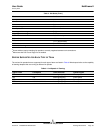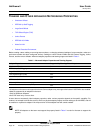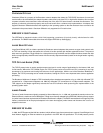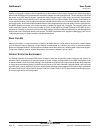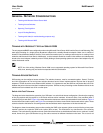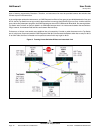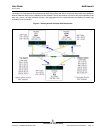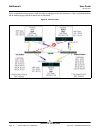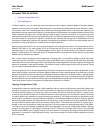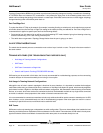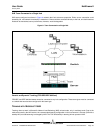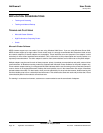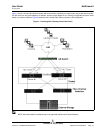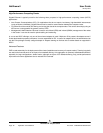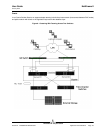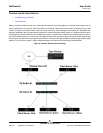
User Guide NetXtreme II
January 2010
Broadcom Corporation
Document ENGSRVT52-CDUM100-R General Network Considerations Page 43
SPANNING TREE ALGORITHM
• Topology Change Notice (TCN)
• Port Fast/Edge Port
In Ethernet networks, only one active path may exist between any two bridges or switches. Multiple active paths between
switches can cause loops in the network. When loops occur, some switches recognize stations on both sides of the switch.
This situation causes the forwarding algorithm to malfunction allowing duplicate frames to be forwarded. Spanning tree
algorithms provide path redundancy by defining a tree that spans all of the switches in an extended network and then forces
certain redundant data paths into a standby (blocked) state. At regular intervals, the switches in the network send and
receive spanning tree packets that they use to identify the path. If one network segment becomes unreachable, or if spanning
tree costs change, the spanning tree algorithm reconfigures the spanning tree topology and re-establishes the link by
activating the standby path. Spanning tree operation is transparent to end stations, which do not detect whether they are
connected to a single LAN segment or a switched LAN of multiple segments.
Spanning Tree Protocol (STP) is a Layer 2 protocol designed to run on bridges and switches. The specification for STP is
defined in IEEE 802.1d. The main purpose of STP is to ensure that you do not run into a loop situation when you have
redundant paths in your network. STP detects/disables network loops and provides backup links between switches or
bridges. It allows the device to interact with other STP compliant devices in your network to ensure that only one path exists
between any two stations on the network.
After a stable network topology has been established, all bridges listen for hello BPDUs (Bridge Protocol Data Units)
transmitted from the root bridge. If a bridge does not get a hello BPDU after a predefined interval (Max Age), the bridge
assumes that the link to the root bridge is down. This bridge then initiates negotiations with other bridges to reconfigure the
network to re-establish a valid network topology. The process to create a new topology can take up to 50 seconds. During
this time, end-to-end communications are interrupted.
The use of Spanning Tree is not recommended for ports that are connected to end stations, because by definition, an end
station does not create a loop within an Ethernet segment. Additionally, when a teamed adapter is connected to a port with
Spanning Tree enabled, users may experience unexpected connectivity problems. For example, consider a teamed adapter
that has a lost link on one of its physical adapters. If the physical adapter were to be reconnected (also known as fallback),
the intermediate driver would detect that the link has been reestablished and would begin to pass traffic through the port.
Traffic would be lost if the port was temporarily blocked by the Spanning Tree Protocol.
Topology Change Notice (TCN)
A bridge/switch creates a forwarding table of MAC addresses and port numbers by learning the source MAC address that
received on a particular port. The table is used to forward frames to a specific port rather than flooding the frame to all ports.
The typical maximum aging time of entries in the table is 5 minutes. Only when a host has been silent for 5 minutes would
its entry be removed from the table. It is sometimes beneficial to reduce the aging time. One example is when a forwarding
link goes to blocking and a different link goes from blocking to forwarding. This change could take up to 50 seconds. At the
end of the STP re-calculation a new path would be available for communications between end stations. However, because
the forwarding table would still have entries based on the old topology, communications may not be reestablished until after
5 minutes when the affected ports entries are removed from the table. Traffic would then be flooded to all ports and re-
learned. In this case it is beneficial to reduce the aging time. This is the purpose of a topology change notice (TCN) BPDU.
The TCN is sent from the affected bridge/switch to the root bridge/switch. As soon as a bridge/switch detects a topology
change (a link going down or a port going to forwarding) it sends a TCN to the root bridge via its root port. The root bridge
then advertises a BPDU with a Topology Change to the entire network.This causes every bridge to reduce the MAC table
aging time to 15 seconds for a specified amount of time. This allows the switch to re-learn the MAC addresses as soon as
STP re-converges.



